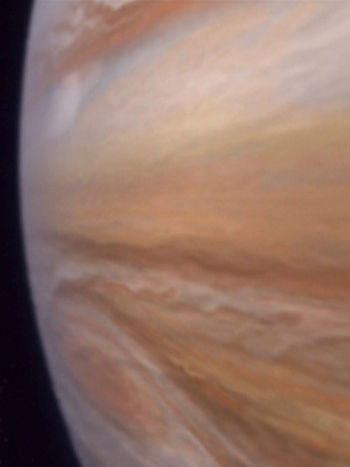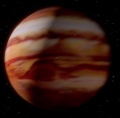Jupiter

| Affiliation: | United Earth Republic,[2] United Federation of Planets[3] |
| Location: | Sol V,[3] Sector 001[4]/Sol Sector, Alpha Quadrant[5] |
| Distance from star: | 778,330,000km (5.2 AUs)[5] |
| Class: | J[5] |
| Diameter: | 142,984km[5] |
| Cloudtop Temperature: | -150°C[5] |
| Gravity: | 2.64g;[5] Galilean moons average 0.2g[2] |
| Natural Satellites: | 16,[5] including Galilean moons: Callisto, Europa, Ganymede, Io[2] |
| Notable Events: | Borg Incursion of 2366[6] |
| Points of Interest: | Jupiter Station[7] |
A Class J planet,[5] Jupiter was the largest planet in the Sol system, and orbited fifth from its parent star.[3] Although Jupiter, being a gas giant, was uninhabitable by humanoid life, Starfleet maintained military and support facilities near and around the planet.[8][7] Jupiter's four largest moons, known as the Galilean moons, were also colonized by private Human commercial enterprises.[2]
Jupiter roiled with constant storms, the most famous of which, the Great Red Spot, remained one of the planet's most popular sightseeing destinations. The Great Red Spot was first observed through a telescope in the 17th century by Galileo Galilei;[2] it was still going strong well into the 24th century.[10] The storms were generated by the heat from the planet's interior; this heat circulated through the atmosphere, keeping the clouds in constant motion. Although direct observation remained impossible well into the 24th century,[11] it was widely accepted that Jupiter had a metallic liquid core.[2]
Jupiter was a part of Human consciousness, essentially, since the beginning of that race's civilization. Early astronomers saw it as a bright light in the night sky, but one that behaved differently than nearly all of the others. In the 17th century, Galileo was the first astronomer to view Jupiter—and its four largest moons—through a telescope. In the late 20th century, unmanned probes explored the Jovian system.[2] By the mid-22nd century, Humans had begun to expand into Jupiter and its moons with outposts like Jupiter Station[8] and the Jupiter Outposts.[6]
Galilean Moons
The Galilean moons—so named in honor of Galileo, who first observed them—were Io (Sol Va), Europa (Sol Vb), Ganymede (Sol Vc), and Callisto (Sol Vd). These moons all had an average gravity of 0.2g, little or no atmosphere, and were composed of silicate rock. Three of the moons—Ganymede, Europa, and Callisto—also had significant amounts of water ice.[2]
Although all settlements in the Jovian system fell under the jurisdiction of the United Earth Republic and the United Federation of Planets, they were also the property of the private entities that established them, and were treated as private property. Considering that the Galilean moons were owned and operated by private concerns, it was perhaps unsurprising that the Humans who lived there lacked the same same feisty independence of many other colonies. Permanent populations were also small, with workers coming and going in shifts that lasted as little as a few months at a time. From time to time, rumors surfaced that undesirable elements—be they the Orion Syndicate or Yridian gangsters—had infiltrated the companies' mining operations, but nothing was ever confirmed.[2]
Ganymede
In 2140, Reykeyser Industrial Metals (RIM) began drafting plans for setting up a mining colony on Ganymede, the largest satellite in the Sol system. The Romulan War put a temporary hold on most extra-planetary development, but when the war ended, the initial surveys had already been completed, and construction began in 2161; the first mining complex began operation in 2162.[2]
Incredibly, the United Earth authorities apparently hadn't considered private exploitation of the Jovian moons, so when RIM moved forward with their plan, no ownership rights had been established. The company, then, simply laid claim to the entire moon. To some observers, this was little better than the corporate land grabs of the 19th-century American frontier. The claim went largely undisputed, however, for a variety of reasons, and the company retained ownership of Ganymede.[2]
By 2370, twenty mine pits dotted Ganymede, all owned in whole or in part by RIM, which had long since established itself as one of Earth's leading producers of steel and other industrial metals. Most of the Ganymedan mines produced iron ore, but some also produced copper or bauxite ores; no precious metals were found on Ganymede. The ore was transported to the company's large processing plant in the bowl of a large crater. A small city, capable of supporting 20,000 workers and dubbed Ganymedeville, grew around the plant.[2]
Ganymedeville was composed of a series of large, airtight domes with powerful artificial gravity and life support systems. It was not an especially colorful place, by most accounts, as it combined the grit of an industrial city with the underdeveloped feel of a frontier town. Conversely, it could also be said that miners returning to the town from a day's work could inject their own particular liveliness.[2]
While the initial costs of establishing the colony were high, they proved over the long term that transporting heavy loads of rock and ore in a low-gravity environment produced cost savings that more than paid back the initial investment. Some of RIM's partners on Ganymede included the Andorian keth Vetra, and, in the late 24th century, the Klingon House of Katath, which had close ties to the Klingon military.[2]
Callisto
Operating in much the same manner as the Reykeyser Industrial Metals concerns on Ganymede, the mining colony on Callisto was wholly owned and operated by Dennis and Young Amalgamated Industries, a Mars-based conglomerate. In 2165, Dennis-Young claimed Callisto in much the same manner as RIM had claimed Ganymede four years earlier. Just as with Ganymede, the acquisition of Callisto was met with only token opposition. By the 24th century, Dennis-Young operated six mining pits, which processed iron ore.[2]
Io
Europa
References
- ↑ "First Flight." Star Trek: Enterprise, Episode 50. Television. 14 May 2003.
- ↑ 2.00 2.01 2.02 2.03 2.04 2.05 2.06 2.07 2.08 2.09 2.10 2.11 2.12 2.13 2.14 "Worlds." Star Trek Role Playing Game, book 7. Game. 2005.
- ↑ 3.0 3.1 3.2 "The Cage." Star Trek, Episode 0. Television. 1965 (Unaired).
- ↑ Cite error: Invalid
<ref>tag; no text was provided for refs namedTNG174 - ↑ 5.0 5.1 5.2 5.3 5.4 5.5 5.6 5.7 "Star Trek: Star Charts." Star Trek. Book. Pocket Books. October 2002.
- ↑ 6.0 6.1 "The Best of Both Worlds, Part II." Star Trek: The Next Generation, Episode 175. Television. 24 September 1990.
- ↑ 7.0 7.1 Cite error: Invalid
<ref>tag; no text was provided for refs namedDS9514 - ↑ 8.0 8.1 Cite error: Invalid
<ref>tag; no text was provided for refs namedENT12 - ↑ "Encounter at Farpoint." Star Trek: The Next Generation, Episodes 101-102. Television. 28 September 1987.
- ↑ 10.0 10.1 "Life Line." Star Trek: Voyager, Episode 243. Television. 10 May 2000.
- ↑ Cite error: Invalid
<ref>tag; no text was provided for refs namedDS9479
Cite error: <ref> tag with name "ST01" defined in <references> is not used in prior text.
Cite error: <ref> tag with name "TNG219" defined in <references> is not used in prior text.

